Martial Arts Mats Guide
How to Select Mats for Your School
When it comes to selecting martial arts mats, there are several considerations to take into account, before even looking at types and brands, which we will cover in this guide. Ultimately, mat selection is about safety, but other things can be just as important to your student’s (especially to parents). Failure to get these aspects right can be a turn off to both students.
Mats Considerations
Injury Due to Mats
I know what you may be thinking, “mats prevent injury”. Overall, this is true. However, many injuries happen due to the incorrect selection of mats, based on the type of training you do within your style.
Sometimes students in grappling-style arts will get injuries when the vinyl surface layer wraps around the toe. Usually, this is in combination with how soft the mat is, as the mat allows the toe to sink in. This can cause compound spiral fractures to the toe, but it isn’t just the toe that this can affect.
If the surface of the mat has good grip with the bottom of the foot, the foot could become immobile when weighted and pressure on the leg at just the right angle could cause damage to the ankle. Additionally, a twist that extends beyond the leg’s normal range could cause an ankle or knee damage.
This isn’t to say that softer mats are a no-go, but rather to consider the type of training and what aspect of your training regimen students will be practicing on a given type of mat. For instance, you may have firmer mats on the main floor and have a few softer foldout mats for junior students to learn to roll on.
One other common injury that occurs on mats is “mat burn”. Therefore, if your students are doing ground work, you may find that smoother mats are less likely to cause this.
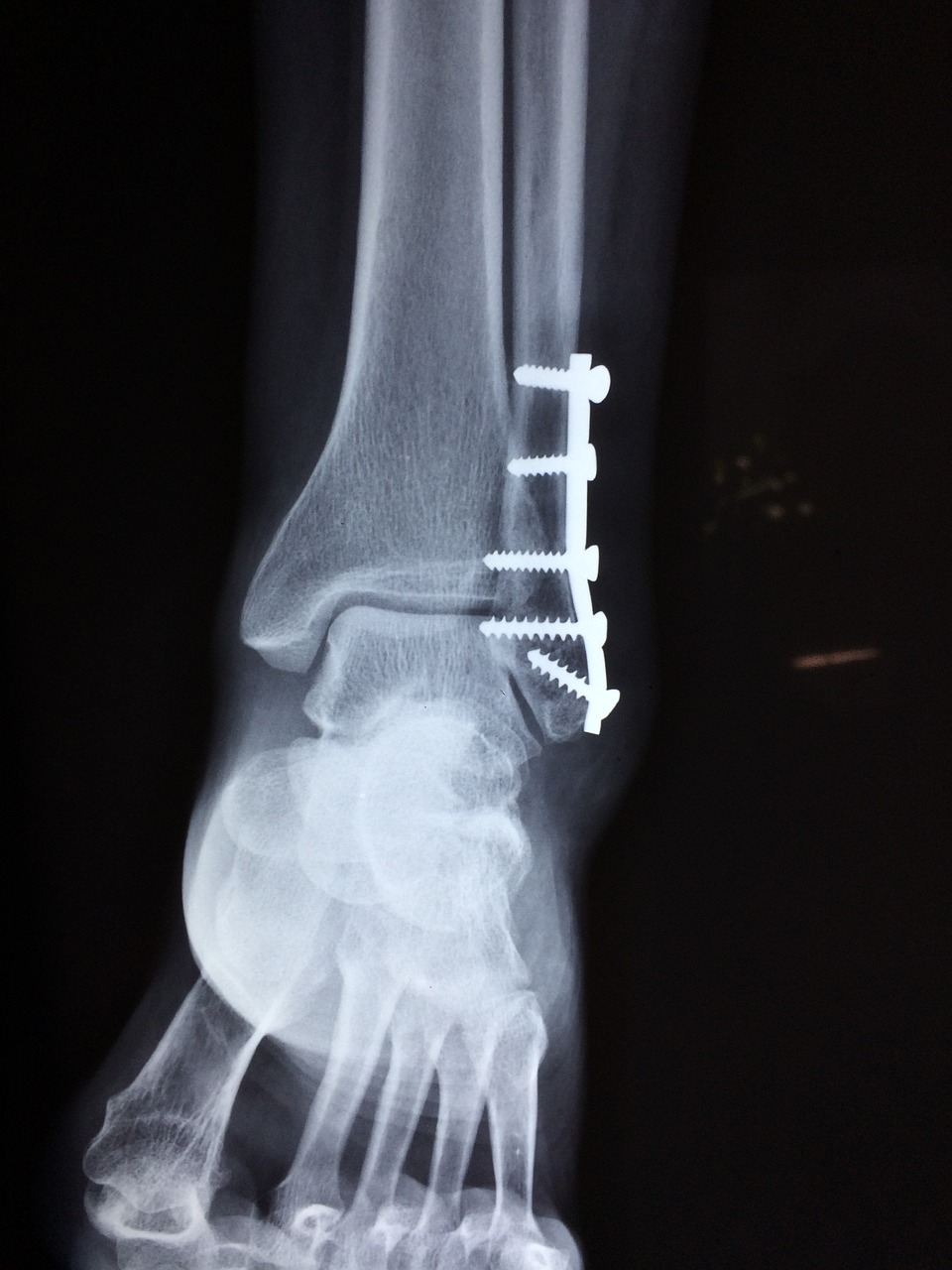
Thickness & Weight Absorption
Thickness and weight absorption are important factors to consider. After all, these relate to the main reasons we train on mats in the first place. As a general rule of thumb, we recommend mats that are at least 1.5” thick, but preferably 2” thick. At the end of the day, your insurance company may silently thank you (and your students may do so openly). The cost of choosing thicker mats like these is worth the money.
Consider this: Yellow belt Johnny breaks his ankle and leaves martial arts forever. Aside from that being a terrible life-altering event for Johnny, he also may had became your best student and paid school fees for the next 10 years. Assuming $100 per month for 10 years, that’s a $12,000 loss. If you can prevent this from happening even once, you have more than made your money back and that’s without looking at insurance costs rising, if you’re sued.
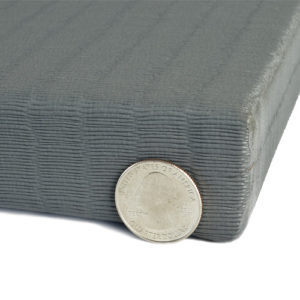
Absorption can be a little deceptive. Not all thick mats have good absorption ratings. Absorption becomes a more important factor when your style involves certain elements of training, such as:
• Rolling (especially if being thrown with both hands locked up is a possibility).
• Shooting for a takedown (think knees here).
• Throwing (such as the hard throws that are common in styles like Judo).
Texture
If you have trained for a tournament or attended a friend’s school, you may have recognized the difference in the mats, which can be especially challenging in a tournament situation. Two factors are most prevalent, as they relate to mat texture, sweat and grip.
For those who train in grappling arts, train topless, or have students who have a tendency to sweat onto the mats a lot, you are familiar with the challenges sweat can play on your training. Overall, this is inevitable. However, the texture of the mat can play a large role in maintaining balance. Some mats have a tatami texture, which does help to mitigate the slickness of the mat, to a degree. If you foresee sweat being a challenge, then consider a more textured mat.
On the flip side of that, I actually like training on a slick surface…in socks. Not all of the time, but it is good to have the option of learning balance, with the safety of not training on the ice during winter. Every style is different, the training methods are different, and you will need to assess the potential challenges for you and your school
Molding & Bacteria
When it comes to sweat, I have heard several BJJ/MMA guys talk about the struggles they face and wish that their mats were better at getting rid of the sweat. For the most part, this is not really possible, because mats are made to not absorb sweat.
While this may seem limiting, it prevents bacterial growth and molding from occurring. If parents see mold on your mats or on the edges/cracks, you can probably count the days until they pull their children (just count backwards from the end of a given month). However, it’s not just parents who may be put off by this, many adults will not appreciate it either.
If sweat is a problem in your school, here are a 4 pro tips for managing it:
Point a large industrial fan toward your mats to take the moisture from the mat surface.
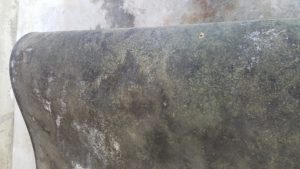
- Ask students to wear a uniform jacket (or at least shirts).
- If you can, keep most rolling toward the beginning of class.
- Have students clean the mats between training sessions. This becomes more important if some students train shirtless, because when they are rolling/grappling, they are also leaving behind oils from their skin. That oil build up can take a toll after a while.
Branding
Depending on the clientele and the overall aesthetics of your dojo, branding your mats could be a very nice touch. Many martial arts mat brands and distributors are capable of putting your logo on your mats, provided you have a vector graphic of your logo.
Like many dojo owners, you may care less about your branding, but a succinctly branded training hall can go a long way in building confidence within members, and especially within parents.
Wall Pads
Depending on your training style, you may find it advantageous to have padding on the walls. This is especially beneficial if your mats run up against the walls. While you and I may be cognizant of a wall, post, or barrier, new students likely will not.
Again, this comes down to overall costs and risk. If a student puts a large hole in your wall, what will that cost to repair and if it keeps happening, will you spend more money getting repairs than you would on wall pads?
Pricing
As you can tell, there are a lot of factors that go into considering mats for purchase. You can’t always assume that a given mat manufacturer has taken these into consideration (although reputable brands definitely have). With that, it’s easy to see why there are varying costs associated with different mat brands and mat types.
While top brands like Fuji, Dollamur (Swain), & Zebra have excellent mat selections, the price tag can also reflect that. If it’s in your budget, then we suggest you do it. You’re guaranteed to get a high quality mat from these distributors.
However, if it isn’t in your budget, you can still get by for a while with more economical mats and then upgrade at a later date. Overall, more economical mats will still get the job done and some economical mats can be somewhat comparable to the top brands, but they may lack the reputation, marketing (and therefore top of mind awareness), and could potentially be of a lesser quality.
Martial Arts Mat Types
Considering that we have already covered aspects like absorption and molding, I will leave that out when discussing mat types. Different mat types have varying aesthetic and functional qualities, which will be the main aspects covered in this section.
Sectional Mats
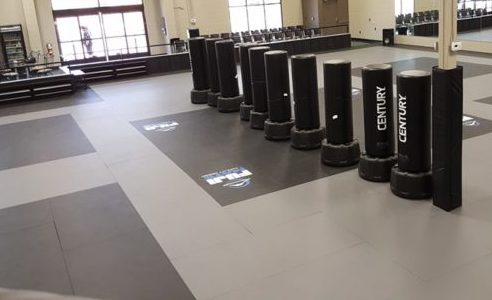
In our opinion, sectional mats have the best appearance and have a lot nice options for displaying your brand on them. While each section can vary in size from company to company, they are typically around 1 x 2 meters or one meter square and the lines between mats are straight, which gives it a clean and uniform appearance.
Sectional mats can be setup in various patterns using two or more colors. This allows for options such as training squares to be setup for matches or training lines for students to practice uniformly.
With this setup, most suppliers can put your logo either on an individual section or span it across multiple sections.
Rollout Mats
There are two types of rollout mats to choose from, traditional and modern. Both have their advantages and disadvantages.
Traditional Rollout
If you have ever seen a high school wrestling match, this is a traditional rollout mat. Both the mat and the mat surface is one unit and it is flexible enough to roll up. These are good for mats that aren’t going to be rolled and unrolled regularly, but you would still like the option.
On the downside, if you were ever on the high school wrestling team, you know what a beast they can be to rollup. Depending on the dimensions of the mat, you may need at least 2 adults to roll them up, but 3 or more is recommended. However, the mats tend to need to be coerced into rolling up straight. For this reason, they are not always convenient if they will need to be stored frequently.
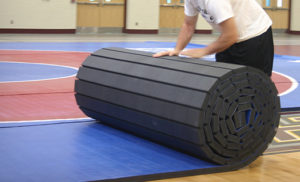
Modern Rollout
This type of mat is a more modern version of the traditional rollout mats, except the padding portion is segmented and held together with the mat surface material. They often come in shorter sections and can be pieced together. This makes it more practical for moving them around and storing them.
On the downside… While it’s stronger than it looks, it is inevitable that much of the strength of the mat is lost when the padding section is segmented like this. All of the load of keeping those padding sections together is rests upon the top layer.
If you choose to order this type of mat and you plan to move it frequently, you may consider shorter sections. For instance, if your mat space is going to be 24’x24’, instead of choosing 6’x24’, you might opt for twice as many sections of 6’x12’. This will put less strain on the mat itself as it is being lifted and moved. They will also be easier to move, as the weight of the mats will also be cut in half.
Puzzle Mats

Puzzle mats are also a good choice, especially if you want something that can be easily taken up and moved. These mats typically come in 3’x3’ sections and the interlocking aspect ensures that the mat does not move, when pressure is put on it diagonally.
Like sectional mats, puzzle mats are easy to color code and make designs on your mat floor.
On the downside… Depending on the brand, these can be a little more firm than other styles of mat, but they still get the job done. While patterns can be made with them, your lines will be squiggly, do to the interlocking nature of puzzle mats. From a distance, this is barely noticed.
Foldout Mats
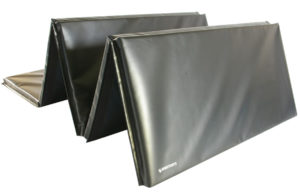
Foldout mats can be a good option, if you need to move them regularly. They stack very well, they are easy to move, easy to place, and they often have velcro on the undersides to help them stay together.
Potential downsides: If you do choose to purchase these, find foldout mats that have a rubber underside or purchase non-slip material to go beneath them. One of the biggest downsides to foldout mats is they can easily slide when diagonal pressure is put against them. Both the velcro and the rubber bottoms can help to keep things in place while students train.
Landing Mats
Larger sections of thick padding can be used when newer students (especially younger students)are practicing throws or when learning to jump over objects and roll out. Four to eight inches of padding is ideal for learning to land safely out of these throws and rolls.
While this is not 100% necessary, it goes a long way in communicating (especially to parents) that you are very conscious of safety and that students have options if they are feeling trepidatious about a particular aspect of training.
Spring Flooring Systems
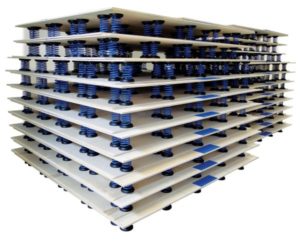
If you are wanting to go the extra mile to make your gym the safest it can be, you might consider installing a spring flooring system under your mats. These springs are attached to sections of plywood, then an additional layer of plywood is applied to help shock be evenly dispensed across the surface of the mat. This process makes the mats more forgiving.
Here is a video on the installation process:
Popular Brands & Economical Brands
Disclaimer: Due to varying needs of schools and varying training methods, we are not specifically recommending any particular brand of martial arts mats over another. We are segmenting brands into two categories, Popular and (potentially more) economical brands. style
Also, this list is specifically for a USA & Canada based audience and the listed manufacturers and distributors are US or Canada based. Shipping for mats can be pricey, so keeping things close by is more advantageous.
If you are a mat manufacturer and we have not listed you, please reach out via our contact form and we will consider adding your line to this article. Likewise, if you are a school owner and you have alternative recommendations, please let us know!
While we do recommend 1.5”+ mats, we are listing some manufacturers/distributors who supply thinner mats as well.
